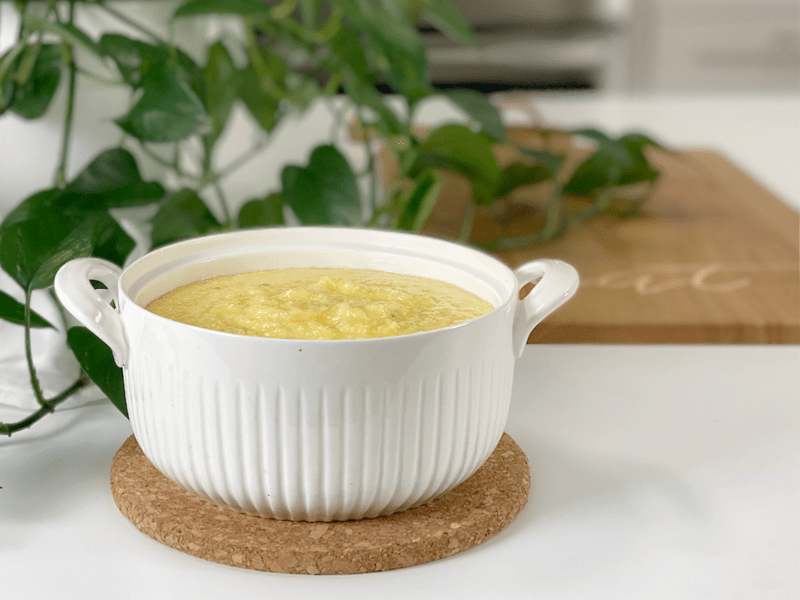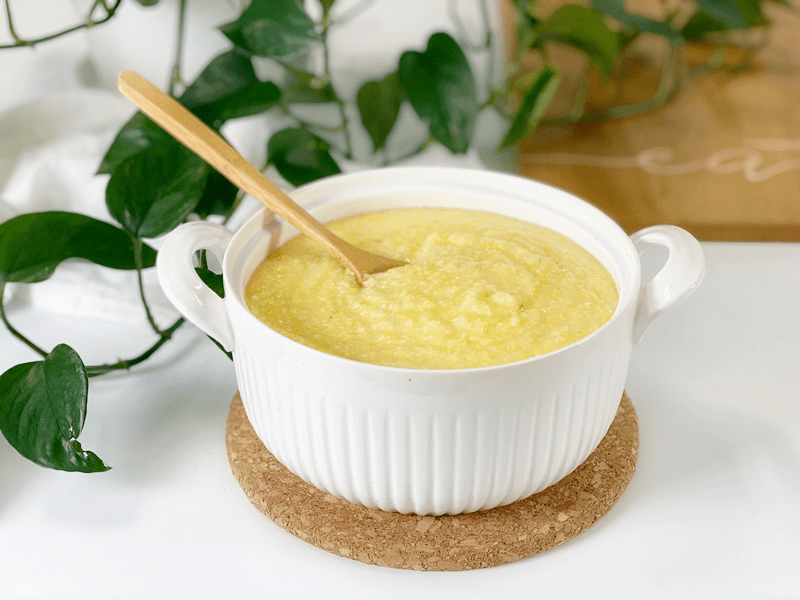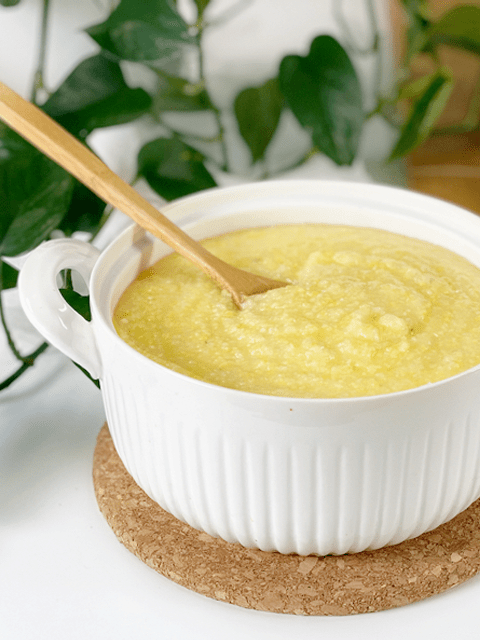Italian Corn Porridge | Soaked | Stove-Top | Oil-Free

 Add to favorites
Add to favorites
Italian cornmeal (also called polenta) is a common dish in Northern Italy. It can be enjoyed like a thick porridge, or it can be cooled, sliced, fried, grilled, or baked. I have always enjoyed it as a breakfast to help take the chill off. It is gluten-free, nut-free, vegan, and low fat. If you are a lover of porridge, I have a feeling that you will love polenta (or you may be familiar with it already).

Polenta didn’t enter my life until Bob did. Growing up, my go-to porridge (and rare treat) was cream of wheat. In my early thirties, I fell in love with grits. It was a daily obsession for one and a half years. I ate it every day for lunch at work. Two packets of instant grits, microwaved with water, followed by a dollop of peanut butter, raisins, and Sweet ‘n Low (gasp!). It was inexpensive, quick, easy, and filling. Trust me, I was ruthlessly teased by my workmates, but it didn’t stop me from enjoying it. When Bob came into my life, he tried my grits but quickly converted me to polenta. Today, I would like to share with you what I have learned through my experiments.
Cooking Liquid
- Plant-Based Milk – makes an incredibly rich and creamy polenta that’s an indulgence all on its own.
- Vegetable Broth – infuses the polenta with much more flavor.
- Water – creates a more neutral polenta that allows the corn flavor to shine through. Plus when cooked right, it still turns out incredibly creamy (but less heavy than when made with milk).
Polenta to Water Ratio
- 1:5 polenta to water ratio
- The tried and true ratio that I found successful is five parts water to one part polenta by volume. The issue when using less liquid than that is that it fails to fully hydrate the cornmeal. It may thicken faster and appear to be done sooner, but the little bits of dried corn will retain an unpleasant crunch. In essence, too little water makes polenta that’s undercooked and gritty.

Soaking Polenta & Cooking Time
Reduces Cook Time
- To create the best polenta texture (soft, moist, spreadable, spoonable, and creamy) we need to fine-tune the cooking technique. Part of my technique is to presoak the polenta overnight before cooking it. There’s a twofold benefit to this. First, soaking will fully hydrate the polenta before you start cooking it, which drastically cuts down on the cooking time.
Reduces Phytic Acid
- The second benefit is that soaking helps to reduce the phytic acid found in corn. It’s the same concept as when soaking grains, nuts, seeds, and beans. Many people cook the polenta in the soaking water. Personally, I rinse it to remove any tanginess from the apple cider vinegar. Since the grains are small, you will want to drain it through a nut bag.
Increase the Flavor
- As mentioned above, soaking polenta softens each grain, which in turn maximizes flavor.
Different Ways to Enjoy Polenta
- For a sweet dish, you can top it with berries, nuts, maple syrup, honey, and jams.
- For a savory dish, you can serve it up alongside roasted veggies or top with simple my raw Cherry Tomato Marinara Sauce.
- You can also pour the polenta in a 9×11″ baking pan or larger (depending on how thick or thin you want it) and pop it into the fridge to chill all the way through. This will create a thin layer that can be cut into triangles, circles, or squares. Top it with pesto, to replace your traditional bruschetta, or get as creative as you want!
- Skip the toppings altogether, because this polenta is so good it can stand on its own.
Make Every Bite Count
- Purchase ORGANIC (NON-GMO) polenta.
- Presoak the polenta to reduce phytic acid, making it easier on your digestive system.
- Add Kombu seaweed during the cooking process. Read why (here).
- We all know that being present when we eat is very important. Did you know that it’s equally important to pay attention to how it leaves you feeling once you’re done eating? Check-in with your body one or two hours later…see how you feel. Do you feel energized, tired, bloated, or gassy? What is your food telling you?
My goal when making this “recipe” was to keep it straightforward and simple. I am currently eating oil-free and sugar-free; therefore the recipes I create will reflect that because only Bob and I are the ones eating my creations (since COVID-19 socially distanced us from others). Feel free to add healthy fats or sweeteners to this recipe if your palate calls for something extra. Use my techniques as the foundation of many delicious dishes that you can create. Please leave a comment below, blessings, amie sue
 Ingredients
Ingredients
Yields 4 cups
- 5 cups water or vegetable broth
- 1 cup polenta
- 1/4 tsp sea salt
- A 2-4″ strip kombu seaweed
Preparation
Presoak the Polenta
- In a glass bowl combine 2 Tbsp raw apple cider vinegar, 5 cups water, and 1 cup polenta. Give it a quick stir.
- Cover and let sit at room temperature for 12 to 24 hours.
- Rinse the polenta in a tightly woven nut bag to remove the tangy flavor. Some choose to cook the polenta in the soak water. Personally, I strain the soak water and use fresh water when cooking.
Cooking
- Place the soaked, drained polenta into a medium-large saucepan, kombu seaweed, and add the cooking liquid of choice.
- Bring the mixture to a boil (it will thicken quickly as the cornmeal absorbs water).
- Reduce the heat as soon as it starts to show the first signs of spitting, keeping the heat low enough so that the polenta won’t puff, pop, and spit as it cooks.
- If you think watching a pot of water boiling seems like an eternity…
- Stir it every few minutes with a whisk or spoon, making sure to stir along the bottom edges of the pan where it can collect and start sticking.
- As the polenta thickens, it will start pulling away from the side of the pan, which is a sign that it’s close to being done.
- If any lumps form, grab a whisk and give the polenta a good beating.
- After cooking you can remove the seaweed, diced it up small, and add it back in for the additional nutrients. Or you can save it in an airtight container and throw it in the next pot of grains or beans you cook.
- If at any point it becomes too thick, just add some more liquid, and whisk it in. It’ll start off lumpy but will quickly become soft and smooth again.
- At this point, you can spoon the polenta into a bowl and top with whatever you’re serving with it.
- Storing – When it comes to storing hot foods in the fridge, we have a 2-hour window. Large amounts of food should be divided into small portions and put in shallow containers for quicker cooling in the refrigerator that is set to 40 degrees (F) or below. If you leave food out to cool and forget about it after 2 hours, throw it away due to the growth of bacteria. (source)
- It should keep for at least 4 or 5 days in the fridge or can be frozen for up to 3 months.
© AmieSue.com
Tags: AIP Approved, Batch Cooking | Time Savors, Cooked, Gluten Free, Low FODMAP, Nut Free, Oil-Free, Starch Solution, Vegan



 Add to favorites
Add to favorites


 Ingredients
Ingredients